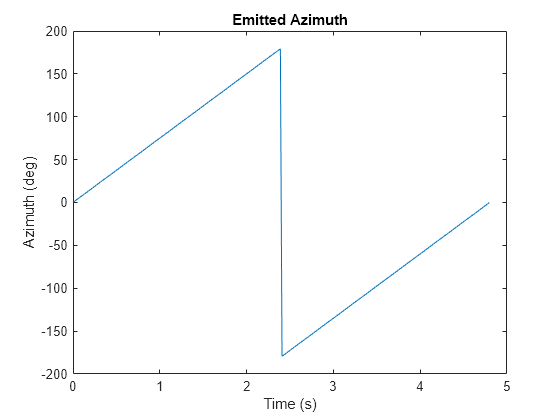radarEmitter
Description
The radarEmitter
System object™ creates an emitter to simulate radar emissions. You can use the
radarEmitter object in a scenario that detects and tracks moving
and stationary platforms. Construct a scenario using radarScenario.
A radar emitter changes the look angle between updates by stepping the mechanical and
electronic position of the beam in increments of the angular span specified in the
FieldOfView property. The radar scans the total region in
azimuth and elevation defined by the radar mechanical and electronic scan limits,
MechanicalScanLimits and
ElectronicScanLimits, respectively. If the scan limits for
azimuth or elevation are set to [0 0], then no scanning is performed
along that dimension for that scan mode. If the maximum mechanical scan rate for azimuth
or elevation is set to zero, then no mechanical scanning is performed along that
dimension.
To generate radar detections:
Create the
radarEmitterobject and set its properties.Call the object with arguments, as if it were a function.
To learn more about how System objects work, see What Are System Objects?
Creation
Syntax
Description
emitter = radarEmitter(EmitterIndex)
emitter = radarEmitter(EmitterIndex,'No scanning')radarEmitter that
stares along the radar antenna boresight direction. No mechanical or
electronic scanning is performed. This syntax sets the
ScanMode property to 'No
scanning'.
emitter = radarEmitter(EmitterIndex,'Raster')radarEmitter object
that mechanically scans a raster pattern. The raster span is 90° in azimuth
from –45° to +45° and in elevation from the horizon to 10° above the
horizon. See Convenience Syntaxes for the
properties set by this syntax.
emitter = radarEmitter(EmitterIndex,'Rotator')radarEmitter object
that mechanically scans 360° in azimuth by mechanically rotating the antenna
at a constant rate. When you set HasElevation to
true, the radar antenna mechanically points towards
the center of the elevation field of view. See Convenience Syntaxes for the
properties set by this syntax.
emitter = radarEmitter(EmitterIndex,'Sector')radarEmitter object
that mechanically scans a 90° azimuth sector from –45° to +45°. Setting
HasElevation to true, points the
radar antenna towards the center of the elevation field of view. You can
change the ScanMode to 'Electronic'
to electronically scan the same azimuth sector. In this case, the antenna is
not mechanically tilted in an electronic sector scan. Instead, beams are
stacked electronically to process the entire elevation spanned by the scan
limits in a single dwell. See Convenience Syntaxes for the
properties set by this syntax.
emitter = radarEmitter(___,Name,Value)radarEmitter('CenterFrequency',2e6) creates a radar
emitter creates detections in the emitter Cartesian coordinate system and
has a maximum detection range of 200 meters. If you specify the emitter
index using the EmitterIndex property, you can omit the
EmitterIndex input.
Properties
Usage
Description
Input Arguments
Output Arguments
Object Functions
To use an object function, specify the
System object as the first input argument. For
example, to release system resources of a System object named obj, use
this syntax:
release(obj)
Examples
More About
Extended Capabilities
Version History
Introduced in R2021a
